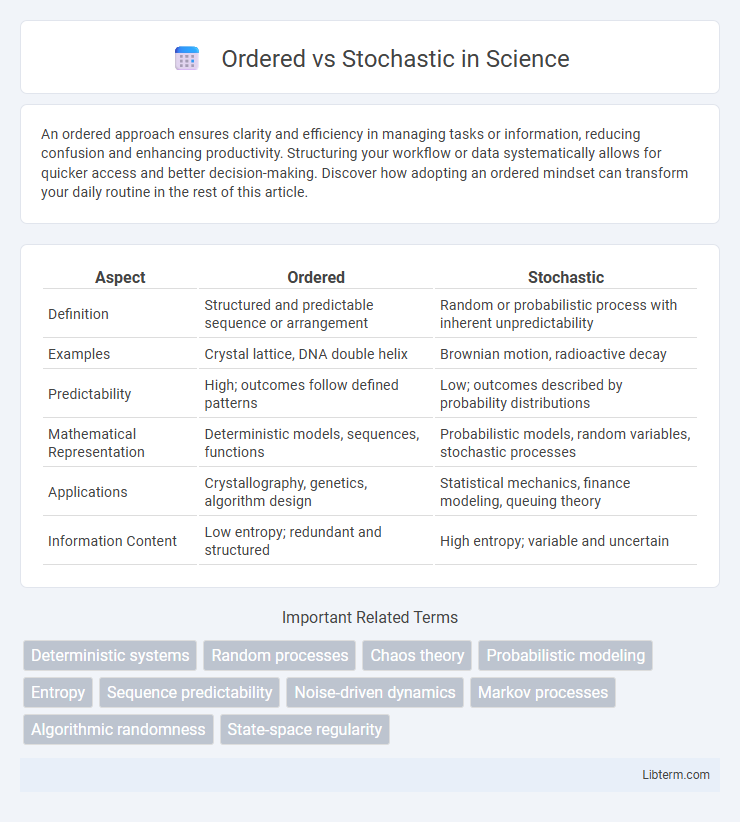An ordered approach ensures clarity and efficiency in managing tasks or information, reducing confusion and enhancing productivity. Structuring your workflow or data systematically allows for quicker access and better decision-making. Discover how adopting an ordered mindset can transform your daily routine in the rest of this article.
Table of Comparison
| Aspect | Ordered | Stochastic |
|---|---|---|
| Definition | Structured and predictable sequence or arrangement | Random or probabilistic process with inherent unpredictability |
| Examples | Crystal lattice, DNA double helix | Brownian motion, radioactive decay |
| Predictability | High; outcomes follow defined patterns | Low; outcomes described by probability distributions |
| Mathematical Representation | Deterministic models, sequences, functions | Probabilistic models, random variables, stochastic processes |
| Applications | Crystallography, genetics, algorithm design | Statistical mechanics, finance modeling, queuing theory |
| Information Content | Low entropy; redundant and structured | High entropy; variable and uncertain |
Understanding Ordered and Stochastic Processes
Ordered processes follow a predictable, sequential pattern where events occur in a deterministic manner, allowing for precise forecasting of outcomes. Stochastic processes involve randomness and uncertainty, with outcomes described by probability distributions rather than exact predictions. Understanding the distinction is crucial for modeling systems in fields such as physics, finance, and computer science, where ordered models suit deterministic behavior and stochastic models capture variability and noise.
Core Differences: Ordered vs Stochastic Systems
Ordered systems operate under deterministic rules where outcomes are precisely predictable based on initial conditions, ensuring consistent behavior and repeatability. Stochastic systems incorporate inherent randomness or probabilistic elements, leading to variable outcomes even with identical starting parameters. This fundamental distinction impacts modeling approaches, with ordered systems favoring exact algorithms and stochastic systems relying on statistical methods to account for uncertainty.
Real-World Applications of Ordered Models
Ordered models provide structured predictions critical in real-world applications such as customer satisfaction ratings, risk assessment scales, and medical diagnosis stages. These models leverage inherent order in response categories to improve interpretability and decision-making accuracy, especially in fields like finance and healthcare where data hierarchy impacts outcomes. Employing ordered models enhances predictive performance by capturing the natural ranking within variables, making them indispensable for practical scenarios requiring ordinal inference.
Where Stochastic Approaches Excel
Stochastic approaches excel in scenarios involving uncertainty, variability, and incomplete information, making them ideal for modeling complex systems such as financial markets, weather forecasting, and machine learning algorithms. They offer flexibility by incorporating randomness and probabilistic elements, which helps in optimizing solutions where deterministic models fall short. These methods are particularly effective in adaptive systems and real-time decision-making processes where dynamic changes occur frequently.
Mathematical Foundations of Ordered and Stochastic Methods
Ordered methods rely on deterministic sequences and structures rooted in linear algebra and combinatorics, enabling precise, repeatable outcomes through well-defined mathematical algorithms. Stochastic methods incorporate probability theory and random variables to model uncertainty and variability, often using Markov chains, Monte Carlo simulations, and stochastic differential equations. Combining ordered frameworks with stochastic analysis enhances modeling complex systems in applied mathematics, statistics, and computational sciences.
Common Misconceptions about Ordered vs Stochastic
Common misconceptions about ordered versus stochastic processes often arise from confusing deterministic outcomes with randomness. Ordered systems are perceived as entirely predictable, but they can involve complex patterns that appear random without thorough analysis. Conversely, stochastic processes, while inherently probabilistic, can exhibit structured behaviors through underlying statistical regularities misunderstood as mere chaos.
Advantages and Limitations of Ordered Systems
Ordered systems ensure predictability and repeatability, which improves reliability and simplifies debugging processes. However, their rigidity limits adaptability to changing environments or unexpected inputs, reducing flexibility in dynamic scenarios. Such systems may also require extensive pre-planning and resources to design, impacting scalability and responsiveness.
Benefits and Drawbacks of Stochastic Models
Stochastic models capture randomness and uncertainty by incorporating probability distributions, making them ideal for simulating real-world systems where outcomes vary unpredictably. Benefits include flexibility to model complex phenomena and the ability to provide probabilistic forecasts, which enhance decision-making under uncertainty. Drawbacks involve higher computational complexity and challenges in parameter estimation, potentially leading to less interpretability compared to deterministic ordered models.
Choosing the Right Approach: Key Considerations
Choosing between ordered and stochastic approaches depends on the nature of the data and the desired outcome. Ordered methods excel in scenarios requiring predictability and sequence integrity, such as time-series forecasting or scheduling, while stochastic methods better handle uncertainty and variability in systems like financial modeling or weather prediction. It's crucial to evaluate computational resources, accuracy needs, and the complexity of underlying processes to determine the most effective approach.
Future Trends in Ordered and Stochastic Research
Future trends in ordered and stochastic research emphasize integration with machine learning to enhance predictive accuracy and model adaptability. Advances in quantum computing are expected to revolutionize stochastic algorithms by enabling faster processing of complex probabilistic models. Increased application of ordered systems in automation and AI promises improved efficiency in deterministic environments while stochastic methods continue to evolve for better uncertainty management in dynamic systems.
Ordered Infographic

 libterm.com
libterm.com